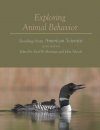About this book
This anthology contains 37 articles published since 1974 in American Scientist, the journal of the scientific society Sigma Xi. While sequenced particularly to complement John Alcock's Animal Behavior, this readily comprehensible and richly illustrated reader can stand alone as a sampler of the excitement and diversity of research approaches and organisms that constitute the modern study of animal behavior.
Contents
Part I. Doing Science and Studying Behavior
Edward O. Wilson. 1998. Scientists, scholars, knaves and fools. 86:6-7.
James Woodward and David Goodstein. 1996. Conduct, misconduct and the structure of science. 84:479-490.
George D. Gopen and Judith A. Swan. 1990. The science of scientific writing. 78:550-558.
Ernst Mayr. 1974. Behavior programs and evolutionary strategies. 62:650-659.
Kay E. Holekamp and Paul W. Sherman. 1989. Why male ground squirrels disperse. 77:232-239.
Sarah Blaffer Hrdy. 1977. Infanticide as a primate reproductive strategy. 65:40-49.
Part II. The Adaptive Value of Social Behavior
Thomas D. Seeley. 1989. The honey bee colony as a super-organism. 77:546-553.
Thomas D. Seeley, P. Kirk Visscher, and Kevin M. Passino. 2006. Group decision making in honey bee swarms. 94:220-229.
David Sloan Wilson and Edward O. Wilson. 2008. Evolution for the good of the group. 96:380-391.
Stephen T. Emlen, Peter H. Wrege, and Natalie J. Demong. 1995. Making decisions in the family: An evolutionary perspective. 83:148-157.
Bernd Heinrich and John Marzluff. 1995. Why ravens share. 83: 342-349.
Rodney L. Honeycutt. 1992. Naked mole-rats. 80:43-53.
Warren G. Holmes and Paul W. Sherman. 1983. Kin recognition in animals. 71:46-55.
Robert R. Provine. 2005. Yawning. 93:532-539.
Part III. The Adaptive Value of Reproductive Behavior
Randy Thornhill and Darryl T. Gwynne. 1986. The evolution of sexual differences in insects. 74:382-389.
Robert R. Warner. 1984. Mating behavior and hermaphroditism in coral reef fishes.72:128-136.
William G. Eberhard. 1990. Animal genitalia and female choice. 78:134-141.
Peton M. West. 2005. The lion’s mane. 93:226-235.
Lowell L. Getz and C. Sue Carter. 1996. Prairie-vole partnerships. 84:56-62.
Douglas W. Mock, Hugh Drummond, and Christopher H. Stinson. 1990. Avian siblicide. 78:438-449.
David M. Buss. 1994. The strategies of human mating. 82:238-249.
Part IV. The Evolutionary History of Behavior
Bert Holldobler and Edward O. Wilson. 1983. The evolution of communal nest-weaving in ants. 71:490-499.
William A. Shear. 1994. Untangling the evolution of the web. 82:256-266.
Gerald Borgia. 1995. Why do bowerbirds build bowers? 83:542-547.
Lyudmila N. Trut. 1999. Early canid domestication: The farm-fox experiment. 87:160-167.
Paul Sherman and Samual M. Flaxman. 2001. Protecting ourselves from food. 89:142-151.
Part V. The Mechanisms of Behavior
Gene E. Robinson. 1998. From society to genes with the honey bee. 86:456-462.
John C. Wingfield, Gregory F. Ball, Alfred M. Dufty, Jr., Robert E. Hegner, and Marilyn Ramenofsky. 1987. Testosterone and aggression in birds. 75:602-608.
Stephan J. Schoech. 1998. Physiology of helping in Florida scrub-jays. 86:70-77.
Andrew H. Bass. 1996. Shaping brain sexuality. 84:352-363.
Mike May. 1991. Aerial defense tactics of flying insects. 79:316-328.
Part VI. Communication Behavior at Four Levels of Analysis
William A. Searcy and Stephen Nowicki. 2008. Bird song and the problem of honest communication. 96:114-121.
Meredith J. West and Andrew P. King. 1990. Mozart’s starling. 78:106-114.
Walter Piper, Jay Mager, and Charles Walcott. 2011. Marking loons. 99:220-227.
Kendra Sewall. 2012. Vocal matching in animals. 100:306-315.
Todd M. Freeberg, Jeffrey R. Lucas, and Indrikis Krams. 2012. The complex call of the Carolina chickadee. 100:398-407.
Madallena Bearzi and Craig Stanford. 2010. A bigger, better brain. 98:402-409.
Customer Reviews
Biography
Paul W. Sherman is a Professor in the Department of Neurobiology and Behavior at Cornell University, where he teaches courses focusing on Animal Behavior and Darwinian Medicine. He was an undergraduate at Stanford, a graduate student at Michigan, and a Miller Postdoctoral Fellow at Berkeley. Dr. Sherman has published or edited seven books and 195 papers and book chapters. His research has contributed to scientific understanding in six general areas: altruism and nepotism, kin recognition, eusociality, the evolution of sex, conservation biology (especially the concept of evolutionary traps), and Darwinian medicine (especially the adaptive significance of morning sickness, allergies, spice use, lactose intolerance, and senescence). Dr. Sherman was a Sigma Xi National Lecturer (2004–2006) and was elected a Fellow of the Animal Behavior Society (2004). In 2005, he was appointed an S. H. Weiss Presidential Fellow in recognition of “effective, inspiring, and distinguished teaching.”
John Alcock is Regents’ Professor Emeritus of Biology at Arizona State University. He received his Ph.D. from Harvard University under the direction of Ernst Mayr. His research deals with the behavioral ecology of insect mating systems, with projects that have taken him from Arizona to Costa Rica and Australia. He wrote The Triumph of Sociobiology (2001) and coauthored The Evolution of Insect Mating Systems (1983) with Randy Thornhill. Alcock has also written seven other books on animal behavior and natural history for general audiences. One of these, In a Desert Garden, received the Burroughs’ Award for natural history writing in 1998. Dr. Alcock also received the Dean’s Quality Teaching Award the first year it was given at Arizona State University.


































